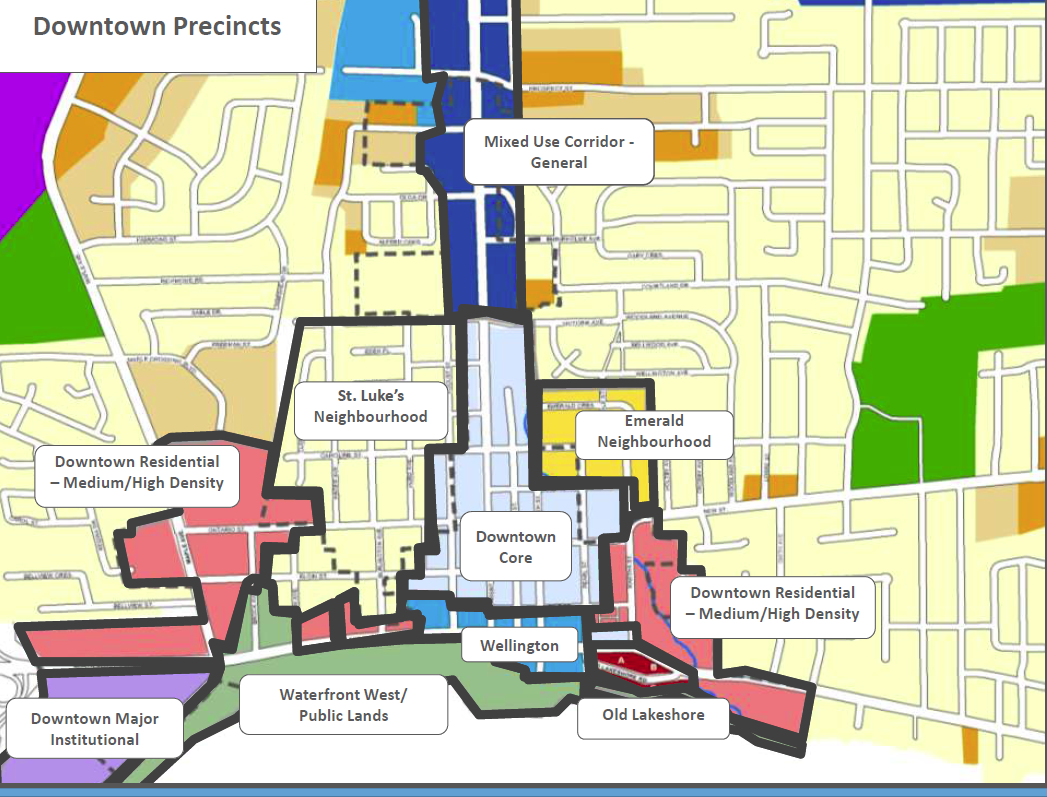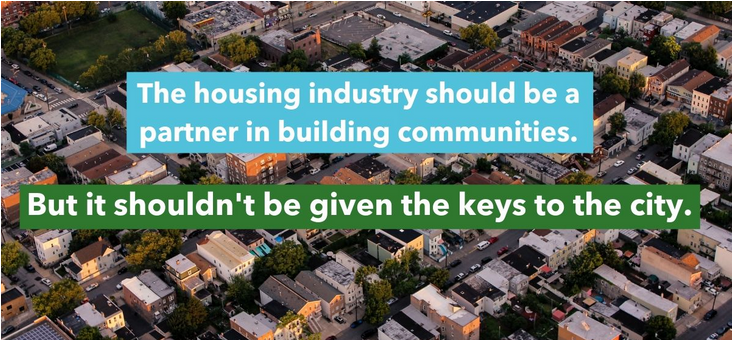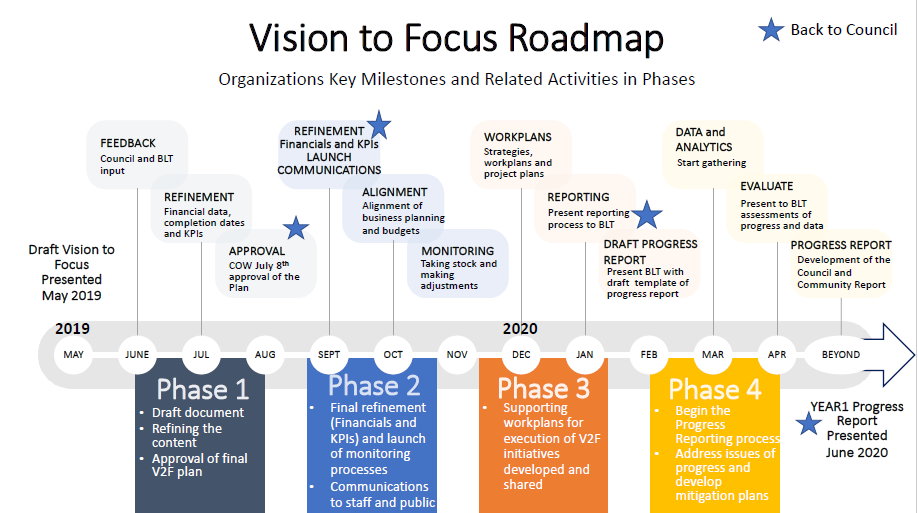 By Pepper Parr
By Pepper Parr
July 29th, 2019
BURLINGTON, ON
Despite a year of significant upheaval in the Planning department – staff are now working on several critical reports with tight time frames – and developing ways to include the public in the process on an ongoing basis and not when it is all wrapped up.
Planning staff are well into the Work Plan for the scoped re-examination of the Adopted Official Plan.
It is a mammoth task that has to be done right if Mayor Marianne Meed Ward is to meet the mandate the public gave her in October.

City planner, Heather MacDonald , on the right, in conversation with Blair Smith
The Planning and Development Committee set out what the Department of City Building is expected to get done during the summer.
Along with the re-examination of the Adopted Official Plan the City Building Department has to figure out just what they want to allow in the way of development in the city core – now that there is a freeze on all development in the core.
Direct the Director of City Building to proceed with the work identified
Direct the Director of City Building to propose refinements to the Neighbourhood Centre’s Policy to simplify and clarify the intent of the policies, generally described in section 4.2.3; and
Direct the Director of City Building to modify the terms of reference upon confirmation of impacts related to Bill 108 and other Provincial changes to the land use planning and development system, if required.
All this began when city council adopted a new Official Plan. That plan was sent to the Region which is the approval authority for the Official Plan.
On December 4, 2018, the day after the new city council was sworn in, the Region of Halton provided a notice to the City advising that the adopted Official Plan does not conform with the Regional Official Plan in a number of respects. The effect of the notice extends the Region’s review process indefinitely, until such time as the Region determines that the non-conformity is rectified. The supporting information identified that:
The City of Burlington can make additional modifications before the plan is approved by the Region where there is appropriate planning justification and public consultation. Any modifications would need to be assessed for conformity against the Regional Official Plan and Provincial Plans and policy statements.

The night the election was won.
That statement gave the new Mayor a free hand to look at everything in the plan that had been adopted by the previous council despite considerable opposition to the plan from a large portion of the public.
In February, 2019 Council provided a staff direction to re-examine the policies of the adopted Official Plan:
Direct the Director of City Building to immediately commence a process to re- examine the policies of the Official Plan adopted April 26, 2018 in their entirety related to matters of height and intensity and conformity with provincial density targets.
A Council workshop was held on March 18, 2019 to obtain further Council feedback on this direction, which has resulted in the scope of work.
To prepare for the Council Workshop, a series of meetings with Councillors were undertaken. The result of these meetings was a list of issues relevant to each Councillor, which informed the preparation for the Council Workshop.
A number of key themes emerged from the workshop discussion. It was clear that Council agrees that the work identified should be completed by the end of Q1 2020. That is eight months away.
Through discussion at the workshop it was agreed that the adopted Official Plan brings in new policies and forward looking approaches to land use planning and growth. In general, Council supports the majority of the policies within the adopted Official Plan.
Two key areas emerged as requiring further consideration: the Downtown Precinct Plan and the Neighbourhood Centre policies.

A precinct is not limited to a single given area: it is rather a description of what can be done in an area within the named precinct.
It was acknowledged at the workshop that the Official Plan is not intended to provide detailed land use policies for specific sites. As a result there is a role for more detailed land use planning processes. These processes can include both detailed, city-led area specific planning exercises such as area-specific plans, or site-specific development applications for Official Plan and/or Zoning Bylaw Amendments.
Coming up with an Official Plan that could be defended has never been a slam dunk for Burlington. Almost everything they do gets challenged – costing the city a bundle in legal fees and months of work time dealing with the appeals.
To this end, staff and consultants will need to work together to prepare modifications to policies, based on technical information and public and stakeholder input, which demonstrate the functionality and feasibility of a recommended scenario in conformity with the Regional Official Plan and Provincial Plans and policy statements.
It was no surprise to anyone that throughout all the questions and discussions at the workshop was the role community would play – this council was elected to ensure that the community was at the table.
The results had to be reflective of the community’s vision for the future of Burlington;
– Be that residents believe that the Official Plan represents their values for the future of the City;
– Be supported by an effective public engagement process; and
– Be supported by the public.
Staff agree that the work to re-examine the Official Plan must be supported by a public engagement process and a decision-making process that all stakeholders can understand and agree to in principle. As identified generally by Council, this need for public satisfaction of the plan must be married with the desire to develop a plan that is defensible from a land use planning perspective.
In order to achieve success the project team must transparently:
– educate and communicate the givens – the plan must conform to provincial policy.
– identify the questions that are in scope and out of scope;
– collect, analyze and respond to the feedback;
– use the best tools possible to communicate alternatives, short and long-term impacts and their associated benefits and drawbacks;
– describe and continually communicate about decision making processes; and,
– identify process challenges along the way.
It was this need to ensure that the public was informed while the changes were being made and not have a finished plan introduced to an unsuspecting and unaware public that brought out the need for the creation of a communications plan that had input from the public – people sitting at the table with the planners. A major new step for Burlington.

Bill 108 was not only contentious because of the content but also because of the speed with which is was introduced and made law.
Hovering in the background is the impact of Bill 108 which some have described as a Developers Dream Bill. WeloveBurlington provided an excellent over-view of the Bill and its probable impact. Add to this the Provincial Review which is looking at what form the Regional governments will take going forward.
The Strategic Plan, which has up until now been a list of high level values that everyone subscribes to with there being not very much in the way of detail.
Burlington took a different approach – they took the Strategic Plan “vision” and made it the front end of a series of objectives known as V2F – Vision to Focus. There is a detailed list of where in the Strategic Plan this council thinks the focus should be place.
V2F has been labelled “living document”; one that will undergo changes daily if necessary.

It was another new move on how council was going to proceed and keep the public in the loop. Problem now is for the public to keep up.
While all this is going on council has to deal with a number of related high priority initiatives that are identified in the Official Plan and the Strategic Plan such as the Mobility Hub Area Specific Plans and the Housing Strategy.
Tucked in there is the budget this council wants to have in your hands before Christmas.
These Housing and Mobility Hub initiatives have been postponed given Council’s focus on the re-examination of the Official Plan and the Interim Control Bylaw Land Use Study as well as the work addressing areas of non-conformity of the adopted Official Plan with the Regional Official Plan and given the uncertainty related to the Region’s Official Plan Review.
The March Council Workshop identified two key areas of the Adopted Official Plan that must be included in the scoped re-examination of the adopted Official Plan to guide the next year of work:
a modified precinct plan for the Downtown Urban Centre;
and a review of the Neighbourhood Centre’s policy.
In order to get a solid grip on just what the scope of work was Planning department staff had to be fully conversant with what came out of the March Council workshop; the Motions related to the Downtown Urban Centre that were not passed during the adoption process; the non-Official Plan related Council directions identifying issues to be considered through the Downtown Area Specific Plan; the Commercial Strategy Study recommendations related to the Downtown, with specific attention to small scale retail in the downtown; and the details of Interim Control Bylaw Land Use Study.
This is no small matter.
The Downtown Precinct Plan in the adopted Official Plan was based upon a vision at full build out. Council wanted staff to look at a shorter planning horizon which resulted in a modified precinct plan for the Downtown Urban Centre that would have a planning horizon of 2031, in conformity with provincial policy.
The population and employment forecasts contained in the applicable upper- or single-tier official plan, that is approved and in effect as of July 1, 2017, will apply to all planning matters in that municipality, including lower-tier planning matters where applicable.
The background technical work prepared to date for the Downtown area-specific plan, to be finalized through this study, will confirm development constraints and provide clarity on infrastructure capacity and required improvements.
The shift of the scope of this work to the 2031 planning horizon means that there are not likely to be significant infrastructure issues identified through this planning exercise.
The next planning horizon is 2041.
The planners would just like to get what they have in front of them done within the very tight timelines.
The outcome of this work will not constitute an area-specific plan, instead the outcome will be modified policies which will go beyond the high level Official Plan policies that are included in the current adopted Official Plan (April 2018). The modified policies will be developed to ensure that the City can conform with the Growth Plan policy to accommodate 200 people and jobs per hectare combined within the Urban Growth Centre boundary by considering the findings of technical work and public, agency, and stakeholder feedback.
What is going to get a very close review are all precincts within the Downtown Urban Centre where significant concerns regarding height and density were raised by the current Council;
– All precincts impacted by motions not passed when considered by the previous Council in the development and finalization of the adopted Official Plan;
– Specific policies identified to be modified based on the technical work;
– Small scale retail in the Downtown;
– Built form transition to adjacent residential areas;
– Heritage conservation and cultural heritage resources;
– Flexible streets
The Proposed Terms of Reference do not address:
– Shifting the Urban Growth Centre from the downtown to Burlington GO. The Urban Growth Centre location is established in the Growth Plan for the Greater Golden Horseshoe and the Region of Halton Official Plan. Any policies proposed for the Official Plan must conform with both;
– Major Transit Station Area and Mobility Hub role and function in the downtown as they will be considered in the Interim Control By-Law Land Use study and recommendations will inform this study;
– Transportation or infrastructure assessments to support people and jobs beyond 2031.
– Undertaking a Neighbourhood Character Area study for the St. Luke’s and Emerald precincts. Matters of zoning in the St. Luke’s and Emerald precincts will be considered at the time of the Zoning By-law Review;
– The Old Lakeshore Road Precinct. This area requires a more detailed area specific planning process as identified by adopted Official Plan policy. For more details see Appendix B;
– The Waterfront Hotel Site. This site is subject to a process outlined by a Memorandum of Understanding signed by the City and landowner. For more details see Appendix B;
– Revisions to the Downtown Public Service Precinct. It is expected that the development criteria and other policies of the adopted Official Plan provide sufficient guidance for development in the precinct; and,
– Developing parking rates for the Downtown. Parking rates for intensification areas such as the Downtown are to be addressed through the preparation of site-specific zoning.
Interest was expressed in having the Neighbourhood Centre policies in the adopted Official Plan reviewed.
The role of policy in supporting the redevelopment of Neighbourhood Centres is to establish a detailed policy framework to guide the consideration of site specific development applications. Consistent with the Strategic Plan, the policy framework encourages redevelopment of plazas.
Staff has considered the discussion at the Council Workshop and acknowledge that there is an opportunity to simplify and provide further clarity related to the intent of the Neighbourhood Commercial policies and their relationship to the Strategic Plan. This will be led by staff and would be implemented as part of the proposed modifications to the adopted Official Plan. This work will include:
– Identifying opportunities to clarify and describe the intent of the policy;
– Simplifying language; and
– Clarifying the relationship of the land use policies with the growth framework.
The scope of work proposed has a one-year time frame which was identified as a critical success factor. As discussed at the Council Workshop held on March 18th, another consequence of proposing work that would extend the time frame beyond March 2020 is primarily to shift out the initiation of work for a number of planning studies or initiatives by 12 – 18 months.
When all this was being worked out Bill 108 was not yet the law of the land. Now it is. The Province has also released a new Growth Plan and Provincially Significant Employment Zones Mapping.
Funding of $600,000 from the Policy initiatives reserve fund was approved as part of the 2019 budget for Official Plan related initiatives.
While all this work is taking place a group has been meeting with citizen groups to determine how all this complex information can be put before the public on an ongoing basis. The Gazette wrote about that work in an article last week.
Related news story:



















I have concerns about the consequences for policy changes that arise from the need for the OP having to conform with provincial policy. The primary problem with this arises of course from the key focus on the provincial policies around intensification.
Staff said above: “In order to achieve success the project team must transparently:– educate and communicate the givens – the plan must conform to provincial policy.”
Okay, that’s been the problem all along and the previous Council went with this and always told us that the province was making them do what they were doing in the OP. Now, Planning is telling us again that this is true, but the province doesn’t specify exactly what that means.
However, these provincial policy documents also acknowledge that local official plans are the most important vehicle for implementation of provincial policy.
Intensification is defined in the City’s OP as:
“Development or re-development of a property or site within an existing developed area which is proposed to be undertaken at a higher density or intensity than permitted under the existing zoning, and which may include re-development, (including the re-use of brownfield sites), development on vacant and/or underutilized lands, expansion or conversion of existing buildings, addition of dwelling units, or creation of new lots.”
I think that this definition with no height limit is one part of the city OP policy frame that needs a very close look, especially along with other policies that facilitate intensification, and that are feeding the loss of control and over-development applications that have led to where we are.
These facilitating policies can be easily seen in the OP as it is riddled with “notwithstanding clauses”, and “site specific exception” clauses, defining policies that every application in Ward 1, and for that matter, everywhere in the city that I am aware of, comes forward with in the planning and policy justification documents submitted with applications.
Nobody asks for nominal permissions any more, but there is no limiting policy for control.These appear to be the source of the over-development applications.
I think that this entails serious pitfalls, and needs to be reviewed closely, and revised to remove developer incentives to use it to try and get innumerable variances, amendments, and non-compliance specifications with the base OP and zoning by-law permissions that normally pertain to the development application.
In the specific examples in Ward 1, this allows the applicant to ask for many amendments to change (decrease or increase as relevant) many permissions for heights, FAR, density, setbacks, parking standards, amenity areas, green-space, and so on, that are not in compliance with the OP and bylaws as nominally written.
I am concerned that this device allows developers to turn every application into an argument, and an arbitrary negotiation, attempting to get more than what the OP permissions are as written and intended to apply.
To me, this means that the OP is turned into an outright bargaining instrument, and not in keeping with an objective rules document intended to control and plan how the city develops.
In the only conversation I had with former City Manager Ridge, he told me that the settlement at 421 Brant St was the result of a “negotiation”, and that the existing OP designed by former Director of Planning Bruce Krushelnicki was intended by him to be just such a negotiation instrument.
Mr. Ridges lengthy lead delegation on this application was an unusual endorsement of the negotiated settlement, and the following staff recommendation report left many wondering who in planning really wrote and endorsed it.
The approved application went far and above any written OP, either existing or proposed. It has set a dangerous precedent, with another appeal at 409 Brant St to get the same and/or more approval.
I think that this is the kind of thinking that everything is negotiable, taken beyond its time, context and compatibility, is what has got us into the situation we are in now. It seems now that anything goes, or there is always the LPAT, as some think.
The purpose of objectivity in the OP rules is to restrict and limit arbitrariness, and argument, in any development application the developer chooses to apply this site specific exception provision to.
For example, the adopted but now not Regionally approved OP states that height variances under “Site Specific“ and ”Exception“ variances ”are to be discouraged”. In fact, at present the existing OP and zoning bylaws are in force, and recent applications and approvals have requested amendments such as these, with variances requested to practically everything, and many go beyond permissions contained in the unapproved OP.
So in fact, rather than “discouraged”, such application specific requests are being “encouraged”, and in some cases have been approved – 421 Brant St, 35 Plains Rd. E,, 92 Plains Rd. E (application), 484 Plains Rd (application), and 2100 Brant St (application).
As an example of where this can lead, the approval at 35 Plains Rd is an example of the speculative plays that are being encouraged. This 35 Plains Rd site has never seen the approved application built.
Right now it is a still vacant lot, but with a 72 condo unit approval, it was advertised for sale for $6 million. This was another application approved by planning based on the language of a non-existent and now non-compliant OP, and a still non-existent Mobility Hub concept.
The former Ward Councilor and Mayor Goldring both spoke highly in favor of this application despite not having an OP to support it, going so far as to approve 9 stories instead of 6 permitted. Only our new Mayor did not support this application, and was the only one that understood what was happening.
The clearest example of the shaky ground this kind of thinking in the planning documents rests on, is the recent OMB decision on the ADI development on Martha St. This decision overrides both the existing OP and the proposed, unapproved OP.
In my opinion City planning got it self caught between the languages of the existing OP and the non-existent non-conforming OP and could not come up with a proposal and planning argument to get the OMB chair to consider worthy. This was another indication of the loss of control.
This shows the subjective and arbitrary way in which both OPs are being systematically ignored and undermined, and how Planning is complicit in this.
I think that if this OP and Planning matter is left as big an intensification facilitating mess as it is, in the future it will be subject to this continued abuse and will result in over-development, over-intensification and a lack of objective compatibility that planning rules are supposed to achieve.
If each application is considered on a site specific basis, with exceptions especially, then the planning control intentions of the OP are lost in a sort of arbitrary interpretation, redundant argumentation, and chaos.
If the developers choose to apply under this basis, the objectivity goes out the window, as the developers can easily find a consultant to write a planning justification biased to support the applications. This is their standard operating procedure and why I don’t trust the planners.
II don’t have confidence that the city Planning Dept. is equipped or capable of dealing with this situation in an objective, enforce the OP rules way.
The big question is whether the OP is a substantive, in force and effect document, or is it just a fake, a feckless tool, that allows shortcuts through loopholes that allow the circumvention of the underlying document provisions and permissions.
This is the kind of thing that undermines public confidence in the integrity of the way that planning decisions based on the existing or proposed OPs are being upheld. If they are not upheld, then that’s why people are asking – why bother having an OP?
The City cannot allow itself to consistently enter into negotiations for ever more than OP permissions on every application, that then chews up all the timeline to an appeal to LPAT.
There is far too much money on the table these days, caused by the Grow Bold inflationary expectations created by the last Council and Planning in the development and adoption of a proposed over-development biased OP that is not in compliance with serious practical matters at the Region as we just learned. And not to mention the election results that decisively rejected this very planning and OP model.
If you read the planning justifications you invariably see references to the language of the unapproved proposed OP and saying these amendments requested reflect where the City is going with respect to development.
So following where this mentality leads, we see the speculation that feeds the inflationary expectations driven by more and more height and density that creates overwhelming economic forces and pressures that drives out everything in its path. This is what is happening right now.
In trying to make everything fit, the practical matters of transportation, transit, employment, commercial and retail, necessities of life nearby, traffic, parking and so on cannot just be fixed by reducing all the standards and bylaws to make it look like it will happen.
We cannot just imagine away practical reality with assumptions.
The fix is in drafting an OP that has controlling policies that do not lose control in showing how decisions conform with provincial policies.
Revisions to the definition of intensification and the open-ended entry into site specific exceptions and notwithstanding clauses are the place to start.
I don’t believe the Region had major issues with the plan that would require a total rework. The main deficiencies are that a small group of downtown residents don’t want any development near their homes. They want to remove public transit from the downtown and have all development occur somewhere else – like GO Station parking lots, wow what a great place for those condos! The rest of the plan is probably fine because it doesn’t affect the downtown.
That microscopic bus terminal in downtown Burlington is NOT a mobility hub. Assigning that designation by the previous Council was a pretext to allowing, among other things, that, oh, I don’t know, 22 story developer’s dream on main street across from City Hall (GO DEVELOPERS!). This vote included a Yay from one Council member who I understand spent the maximum number of allowed days during his term in Florida rather than serve his constituents.
I digress. The Go stations are ACTUAL mobility Hubs. That is where any high rise condo development should be happening….like the one at Burlington Go currently.
The Region returned the adopted Official Plan with 4 non-conformities, none of which were related to sections regarding the downtown. New council took this as an opportunity to completely redo the Official Plan. The old Official Plan, revised in 2008, stands until a new plan is accepted by the Region. That old plan has been proven to be indefensible, so the City is in a position where it will be difficult for them to defend an application for a development if they reject it.
Elan, the downtown is a provincially designated Anchor Mobility Hub. This is due to the provincially designated Major Transit Station in the provincially designated Urban Growth Centre. Although a previous council accepted that designation, it is a provincial designation. Burlington GO is the only provincially designated Gateway Mobility Hub in Burlington. It is a Gateway Hub because it cannot be an Anchor Hub, since it is not within the UGC. Anchor Hubs are of a higher order than Gateway Hubs. The other two GO stations are City designated Gateway Mobility Hubs and are of a lower order than the provincially designated hubs. The downtown is not a focus due to it being a MH, it is due to it being an UGC. Tougher to remove that designation than the MH one.
Council wanting to rewrite the OP and trying to undesignate a provincially designation means the current 2008 OP will be around for several years. This leaves the door open for difficult-to-defend applications, not only downtown but throughout the City. On top of that, the Interim Control By-Law only delays the process, putting more pressure on staff and leaving the City open to appeals.
(sorry, my original comment was clipped) … than reporter’s comments, a citation or date line would be helpful for context.
Not having read all the relevant documents, I admit I’m a bit lost at what the City is actually doing. Was the original 2018 OP that much of a mess?. Are staff communicating to all or just a few select groups? Are citizen committees expected to share with the general public? Perhaps it would help if I knew what specific deficiencies were noted by the Region and need to be adressed by Burlington.
And if City/staff reports/comments were identified (different font) to distinguish as different than reporters’ comments.